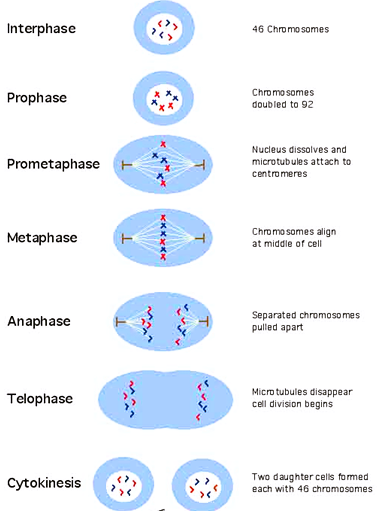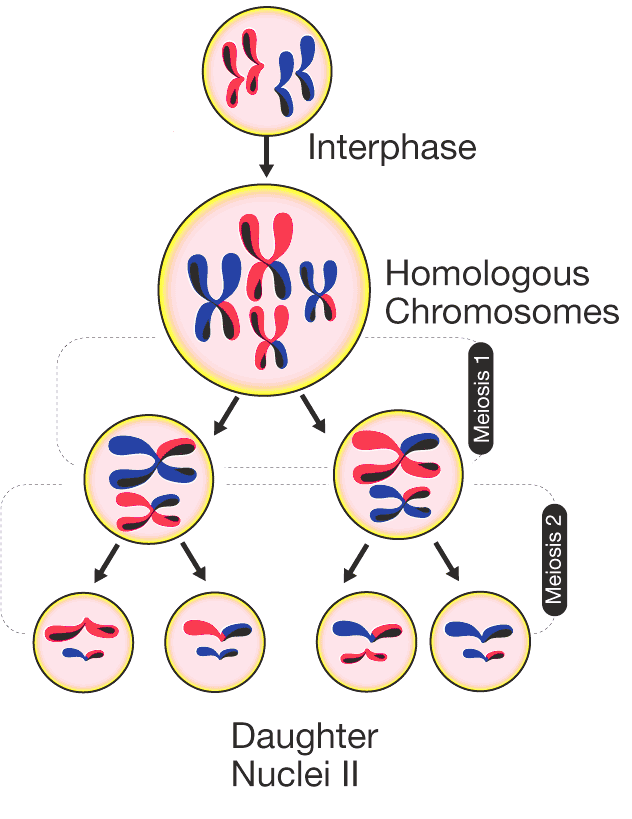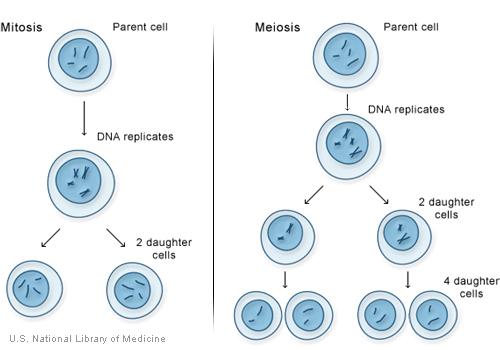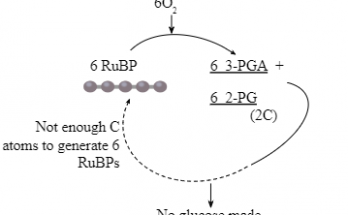Table of Contents
Mitosis and Meiosis
Mitosis and Meiosis are two fundamental cellular processes involved in Cell Division, with distinct differences in their purpose, number of divisions, Chromosome number, mode of Reproduction and genetic diversity
Mitosis is the process of Cell Division that results in the formation of two identical daughter cells from a single parent cell. During Mitosis, the genetic material in the parent cell is replicated and then separated into the two daughter cells. This process is important for growth and repair in multicellular organisms.
Meiosis is a type of Cell Division by which a single cell divides into four non-identical daughter cells, each with half the number of Chromosomes as the parent cell.In Meiosis, the Chromosomes in the parent cell are divided and distributed among the daughter cells in a way that leads to genetic variation in the offspring. This type of Cell Division is responsible for the production of sperm and eggs (gametes) in Sexually reproducing organisms
10 Difference Between Mitosis and Meiosis – In Tabular Format
| Features | Mitosis | Meiosis |
|---|---|---|
| Purpose | General growth and repair | Genetic diversity through Sexual Reproduction |
| Number of divisions | One division | Two divisions |
| Chromosome number | Daughter cells have the same Chromosome number as the parent cell | Daughter cells have half the Chromosome number of the parent cell |
| Synapsis and Crossing Over | Absent | Present, involving synapsis and crossing over for genetic diversity |
| Prophase | Chromosomes condense, spindle fibres form | Prophase I involves synapsis and crossing over, resulting in tetrads or bivalents |
| Metaphase | Chromosomes align at Metaphase plate | Homologous pairs of Chromosomes align, resulting in independent assortment and genetic diversity |
| Anaphase | Sister chromatids separate and move to opposite poles | Homologous Chromosomes separate and move to opposite poles |
| Mode of Reproduction | Occurs in all cells | Occurs only in reproductive cells for Sexual Reproduction |
| Frequency of Occurrence | Occurs frequently in the body | Occurs only during gamete formation |
| Cytokinesis | Occurs in Telophase | Occurs in Telophase I and Telophase II |
| Diagram |  |  |
Difference Between Mitosis and Meiosis- Explained in Details
Difference Between Mitosis and Meiosis in terms of Purpose
Mitosis and Meiosis have different purposes. Mitosis produces two identical daughter cells for general growth and repair, while Meiosis produces four genetically diverse haploid daughter cells for Sexual Reproduction. Mitosis is responsible for the growth and repair of tissues in the body, while Meiosis is responsible for producing gametes (sperm and egg cells) for Sexual Reproduction.
Also Check – Why is Mitosis necessary for Growth?
Difference Between Mitosis and Meiosis in terms of Number of Divisions
Mitosis involves one division of the nucleus, while Meiosis involves two. In Mitosis, a single cell divides into two identical daughter cells. In Meiosis, a single cell undergoes two rounds of division, resulting in four daughter cells.
Also Check – Mitosis in Plants Cell – How Plant Cells Divide from 1 to 2 !
Difference Between Mitosis and Meiosis in terms of Number of Chromosome Number
During Mitosis, the Chromosome number of the daughter cells is the same as that of the parent cell. In contrast, during Meiosis, the Chromosome number is reduced by half, resulting in haploid cells. This reduction in Chromosome number occurs during Meiosis I, when homologous Chromosomes separate.
Difference Between Mitosis and Meiosis in terms of Number of Synapsis and Crossing Over
One of the most significant differences between Mitosis and Meiosis is the occurrence of synapsis and crossing over during Meiosis. Synapsis is the pairing of homologous Chromosomes that occurs during Prophase I of Meiosis. Crossing over also occurs during Prophase I is the exchange of genetic material between non-sister chromatids. These events result in genetic diversity in the daughter cells.
Also Check – Is Meiosis part of the Cell Cycle?
Difference Between Mitosis and Meiosis in terms of Number of Prophase
In Mitosis, Prophase is characterised by the condensation of Chromosomes and the formation of spindle fibres. In Meiosis, Prophase I is more complex and involves synapsis and crossing over, resulting in the formation of tetrads or bivalents. This is the stage where the homologous Chromosomes come together and exchange genetic information, leading to genetic diversity in the daughter cells.
Difference Between Mitosis and Meiosis in terms of Number of Metaphase
In Mitosis, Chromosomes align at the Metaphase plate that is the imaginary line that divides the cell into two halves. This alignment ensures that each daughter cell receives an equal number of Chromosomes. On the other hand, in Meiosis I, homologous pairs of Chromosomes line up at the Metaphase plate. This process is important because it leads to the independent assortment of Chromosomes. Independent assortment means that the way one pair of Chromosomes lines up during Metaphase I does not influence the way another pair lines up. This process results in genetic diversity in the daughter cells.
Difference Between Mitosis and Meiosis in terms of Number of Anaphase
In Mitosis, sister chromatids separate and move to opposite poles of the cell. The spindle fibres attached to the centromeres pull the sister chromatids apart and the cell membrane starts to pinch inwards. This eventually results in the formation of two identical daughter cells.In Meiosis I, homologous Chromosomes separate and move to opposite poles. This separation is important because it ensures that each daughter cell receives a unique combination of Chromosomes. This process also leads to genetic diversity in the daughter cells.
Difference Between Mitosis and Meiosis in terms of Number of Mode of Reproduction
Mitosis occurs in all cells, including somatic (non-reproductive) cells, for the general growth and repair of the body. In contrast, Meiosis only occurs in reproductive cells, such as spermatogonia in males and oogonia in females. Meiosis is important for Sexual Reproduction because it produces haploid gametes that combine during fertilisation to form a diploid zygote. This process ensures genetic diversity in the offspring.
Difference Between Mitosis and Meiosis in terms of Number of Frequency of Occurrence
Mitosis occurs more frequently in the body than Meiosis . It only occurs during gamete formation. Mitosis is a continuous process that occurs throughout the life of an organism. It is responsible for the growth and repair of the body and it occurs in all tissues, including skin, hair and internal organs. In contrast, Meiosis only occurs during gamete formation that takes place during Sexual Reproduction.
Also Check – Where does Mitosis and Meiosis occur ?
Difference Between Mitosis and Meiosis in terms of Number of Cytokinesis
Mitosis and Meiosis both involve Cytokinesis. Cytokinesis is the division of the cytoplasm that results in the formation of two separate daughter cells. In Mitosis, Cytokinesis occurs at the end of Telophase and results in the formation of two identical daughter cells. In Meiosis, Cytokinesis occurs twice, once at the end of Telophase I and again at the end of Telophase II. This results in the formation of four genetically diverse haploid daughter cells.
Similarities Between Mitosis and Meiosis
- Both Mitosis and Meiosis take place in the cell nuclei. It can be observed under a microscope.
- Both Mitosis and Meiosis are processes of Cell Division.
- Both the processes occur in the M-phase of the cell cycle. In both cycles, the typical stages are Prophase, Metaphase, Anaphase and Telophase.
- In both cycles, synthesis of DNA takes place.
- Both processes are preceded by the Interphase, during which the genetic material is duplicated.
- Both processes involve the separation of sister chromatids during Anaphase.
- Both processes utilise spindle fibres to separate Chromosomes during Cell Division.
- Both Mitosis and Meiosis involve the process of Cytokinesis that is the division of the cytoplasm to form two separate daughter cells.
Also Check – Mitosis In Plant Cell and Animal Cell- Differences and Similarities
Also Check- 12 Important Significance of Mitosis
Also Check – 5 Important Significance of Meiosis
Also Check – Is Meiosis part of the Cell Cycle?
Also Check-16 Important Differences between Prokaryotic and Eukaryo


15 Comments on “10 Important Differences between Mitosis and Meiosis”